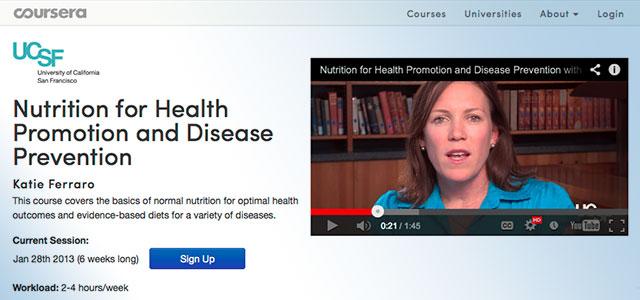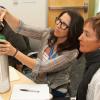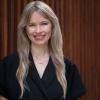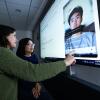
The landing page of the course “Nutrition for Health Promotion and Disease Prevention.”
Advancing the Global Classroom
When Katie Ferraro, a registered dietician and assistant clinical professor at UCSF School of Nursing, recently taught “Nutrition for Health Promotion and Disease Prevention,” the class was filled with the most diverse group of students she had ever encountered.
Instead of the 60 or so graduate-level nursing students usually enrolled in this course, her students numbered more than 57,000 initially, including Heather from Mississippi, a full-time working mom of a disabled son who needs to be fed through a gastric tube.
More than half came from outside the United States, such as Roberto, a psychologist in Italy, who wanted to learn more about nutrition’s role in stress-related illnesses. A young woman from Zambia hoped Ferraro’s lectures would provide important information to improve “nutrient intake” in her local communities, while a secondary-school administrator from the Philippines was curious about how different foods affect students’ health, behavior and learning.
As the six-week course finished in the first week of March, a biology student from Ghana wrote: “This course and its instructors have really inspired so much in me. It was indeed a great honor and pleasure studying with all of you from so many different parts of the globe.”
The World of MOOCs
This student and the others, of course, didn’t gather in a classroom on the UCSF campus. Not even AT&T Park could accommodate so many people. Instead, these people from more than 190 countries met for six weeks in what’s called a massive open online course – popularly known as a MOOC.
They watched videos of Ferraro lecturing on topics such as diet and cancer and weight management. They also viewed, by the thousands, her conversations with guest experts such as the School of Medicine’s Robert Lustig, a professor of pediatrics and author of the new book Fat Chance: Beating the Odds Against Sugar, Processed Food, Obesity, and Disease, which carries his charge against sugar’s role in our national obesity epidemic.
The more than 60 videos accompanying Ferraro’s course were so popular they were downloaded or streamed 1,025,485 times and counting by students who could go back and rewatch them as they researched assignments or prepared for quizzes. And as with most MOOCs, her lectures and other course materials were free. In fact, to receive an educational experience provided by faculty at a world-class institution of higher learning, students just had to sign up on the website for Coursera.
Based in Mountain View, this technology company is one of several leading what the New York Times calls a “seismic shift” in reshaping higher education. Starting in January, UCSF transformed Ferraro’s class and two others into MOOCs to be enjoyed by global audiences. Some 109,000 people signed up for the three courses.
The others were “Clinical Problem Solving,” taught by Catherine Lucey, vice dean for education at the UCSF School of Medicine, and a second from the School of Nursing: “Contraception: Choices, Culture and Consequences,” taught by Jerusalem Makonnen, a family nurse practitioner and assistant clinical professor.
Makonnen’s class likewise attracted a global audience, with 22,138 students from such countries as Nigeria, Portugal and Australia signing up to learn about the latest contraceptive methods.
“It was an incredible opportunity to get involved,” adds Kari Stewart, UCSF’s Coursera project director in the Office of the Vice Chancellor, Student Academic Affairs. “Our mission at UCSF is to advance health worldwide, and this was a way to reach people internationally.”
Going Virtual
Providing online learning isn’t entirely new for UCSF or the School of Nursing. Ferraro has been teaching her course online for seven years.
And in the winter of 2014, the School of Nursing will also launch the first graduate program in the UC system that will be taught mostly online. The one-year Master of Science in Healthcare Administration and Interprofessional Leadership (MS-HAIL) program won’t be open to the general public like the Coursera classes, but to health professionals across disciplines. However, as with Coursera, the program’s online teaching environment will accommodate people anywhere in the world and allow them to schedule class time around their work lives.
MOOCs, however, take accessibility to a whole other level. Coursera’s founders, Stanford University computer scientists Daphne Koller and Andrew Ng, believe in making education taught by the world’s best universities available to millions around the world, “not just to a select few.”
As of mid-March, Coursera had partnered with 62 universities in the United States and internationally – including UC campuses in Berkeley, Irvine, Santa Cruz and San Diego – to offer 330 undergraduate and graduate-level courses in the humanities, science, mathematics, medicine, social sciences and the arts. The site had more than 3 million users by the end of March.
In a March 5 op-ed column, New York Times columnist Thomas Friedman praised MOOCs, disagreeing with traditionalists who say they rob students of valuable face time with professors and classmates. He believes the old model of a student taking notes during a lecture, then regurgitating information back on tests, fails to prepare students to think critically for “a more competency-based world.” With a MOOC or other online classes, students can acquire basic knowledge at their own pace. Classrooms can then become true learning environments, “where the application of that knowledge can be honed through lab experiments and discussions with the professor,” he wrote.
Others see MOOCs as the solution to the class crunch in California’s public two- and four-year colleges and universities, where an increasing number of students are shut out of high-demand classes they need to graduate. The Bill & Melinda Gates Foundation announced in the fall grants to fund the creation of MOOCs designed to serve as remedial and other general education courses. And in March, California State Sen. Darrell Steinberg proposed a bill to establish a platform through which students could take those classes through approved providers outside the state’s higher education system – from companies such as Coursera or its chief competitors, Udacity and edX.
In a statement, UC President Mark Yudof said, “I strongly support efforts to use online education to ensure timely access to courses.” UC Academic Senate Chair Bob Powell told USA Today that he supports online learning, but that UC faculty should be involved in putting together and approving courses to ensure quality instruction.
Works in Progress
When Coursera approached UCSF last June, officials viewed the partnership as an experiment that would involve its share of trial and error. The experiment continues this summer when the School of Dentistry shares one of its courses with Coursera.
“We’re in the very early stages of online learning,” Lucey said in an earlier interview. “Our job is to figure out what works, what doesn’t, and match the methods to the mastery.”
To that end, as part of UCSF’s Teaching Scholars Program, Makonnen will help research the effectiveness of MOOCs versus traditional classes in teaching contraception to nurse practitioner students.
And Coursera itself is a work in progress. Funded with venture capital and investments from the California Institute of Technology and the University of Pennsylvania, Coursera is still working out its revenue model. Its university partners likewise need to figure out ways to make their efforts self-sustaining. Universities bear the costs of paying faculty and staff to run the classes and make them MOOC ready. Once a revenue stream is developed, Coursera and its university partners will share the earnings.
One revenue stream that UCSF has already tested is charging students a fee to receive a verified certificate that serves as an official transcript of their successful participation in the course. The transcript can be shared with current and future employers. This option was attractive to a fair number of students, with 952 in Ferraro’s class signing up to receive the certificates and 360 doing likewise in Lucey’s class, according to Steven Williams, the instructional designer for the UCSF Coursera project.
Another revenue stream UCSF explored was offering continuing education credits. Shortly after UCSF rolled out its MOOCs in January, its Office of Continuing Medical Education agreed to give credits to health care professionals who passed Ferraro’s nutrition class and Lucey’s in clinical problem solving. Physicians in Lucey’s class and doctors and registered dieticians in Ferraro’s course could earn 18 and14 credit hours, respectively, which could be applied to their requirements to maintain professional competency.
Getting Ready for Their Close-Ups
Williams worked with the faculty to turn their “bigger-picture learning objectives” into web-friendly learning experiences. For one thing, faculty had to find study materials that could be made available online; Coursera discourages assigning textbooks that might be costly and unavailable to students in developing nations. Makonnen, for example, says she was fortunate to be able to refer students to the World Health Organization’s global family planning handbook.
Although Ferraro was accustomed to teaching her class online, she still had to restructure her material – notably, condensing a quarter’s worth of material into six weekly chunks. She also moved her lectures from audio to video and prepared quizzes that would be graded automatically and assignments that would be peer reviewed for grades.
Most of the preparation time was devoted to writing and filming the lectures, Ferraro says. Shooting six weeks’ worth of video took 48 hours. “Preparing for the videos took twice that time,” she adds.
In the end, the professional-looking videos were some of the most highly praised features of each class. “It’s a complex but high-quality finished product,” Williams says.
The team agreed not to dilute the graduate-level rigor of the courses to make them more accessible to participants who didn’t have health-related backgrounds; more than 70 percent of enrollees in all three classes had four-year degrees or higher. Ferraro said the team wanted to maintain the high quality of the material they were presenting.
Overcoming Barriers
Once the videos and assignments were uploaded to the Coursera platform, teachers and support staff hoped they could ease into the teaching.
Hardly.
In addition to dealing with some minor technical glitches, Williams said monitoring the discussion boards for the three classes became a full-time job. Makonnen says she could have been online 24/7 responding to student inquiries, while Ferraro says students found her UCSF office number and rang it constantly. Williams helped triage questions and comments, identifying technical or course-related inquiries that needed a response from him or from faculty.
As with any Internet message board, there were a fair share of comments that were off topic, trivial or harshly critical. But for the most part students kept the discussions civil.
Students also found ways to support one another, forming study groups often based on geography (China, Malaysia, Indian subcontinent, Texas), where they shared frustrations, information and solutions to problems in completing assignments.
Still, another of the realities of MOOCs is a dropout rate estimated to be as high as 90 percent.
Nevertheless, in Makonnen’s class, some 8,000 out of the 22,000 who initially registered viewed all the videos, 4,000 took the quizzes and 3,600 participated in the peer assessments. The fact that a majority of students didn’t complete the class doesn’t worry Makonnen, considering the thousands who were able to gain access to the material.
“I feel like the most valuable thing about doing the class this way was the reach,” she says. “There are people around the globe who need this content, and this is just a phenomenal way to provide it.” Makonnen mentioned a nurse in Pakistan working for a nongovernmental organization who wondered when Coursera was going to offer her class again.
Then there was the 46-year-old mother of three with a 12th-grade education. She wrote on the discussion board that dyslexia caused her to struggle in high school and discouraged her from furthering her education. The online format of Makonnen’s course gave her confidence to continue her education and possibly change careers.
“I cannot express how thankful I am!” the woman wrote.
Final numbers were not available for Ferraro’s class, but she estimates a core group of 5,000 out of the initial 57,000 stuck with it. If she’s right, she reached more than 50 times the number of people she reaches in one of her regular UCSF classes.
Excited for the Next Round
Despite the challenges, Ferraro says she is thrilled to be teaching the class again in UCSF’s next round of MOOC offerings.
Her new international fan base – and those they serve – will be very happy to hear that. That base includes a doctor from Somalia who found much of Ferraro’s information on protein and energy especially useful for figuring out ways to better manage malnutrition in his country.
Certainly, there is more work to be done, including figuring out how to maintain course quality, offer credits and ensure adequate revenue streams.
But if it is possible to reach across the globe and, without cost to them, help a physician, nurse or public health official understand how to better address malnutrition and help people in their communities make healthy choices about the food they eat, that is powerful incentive to find solutions to the lesser problems.



